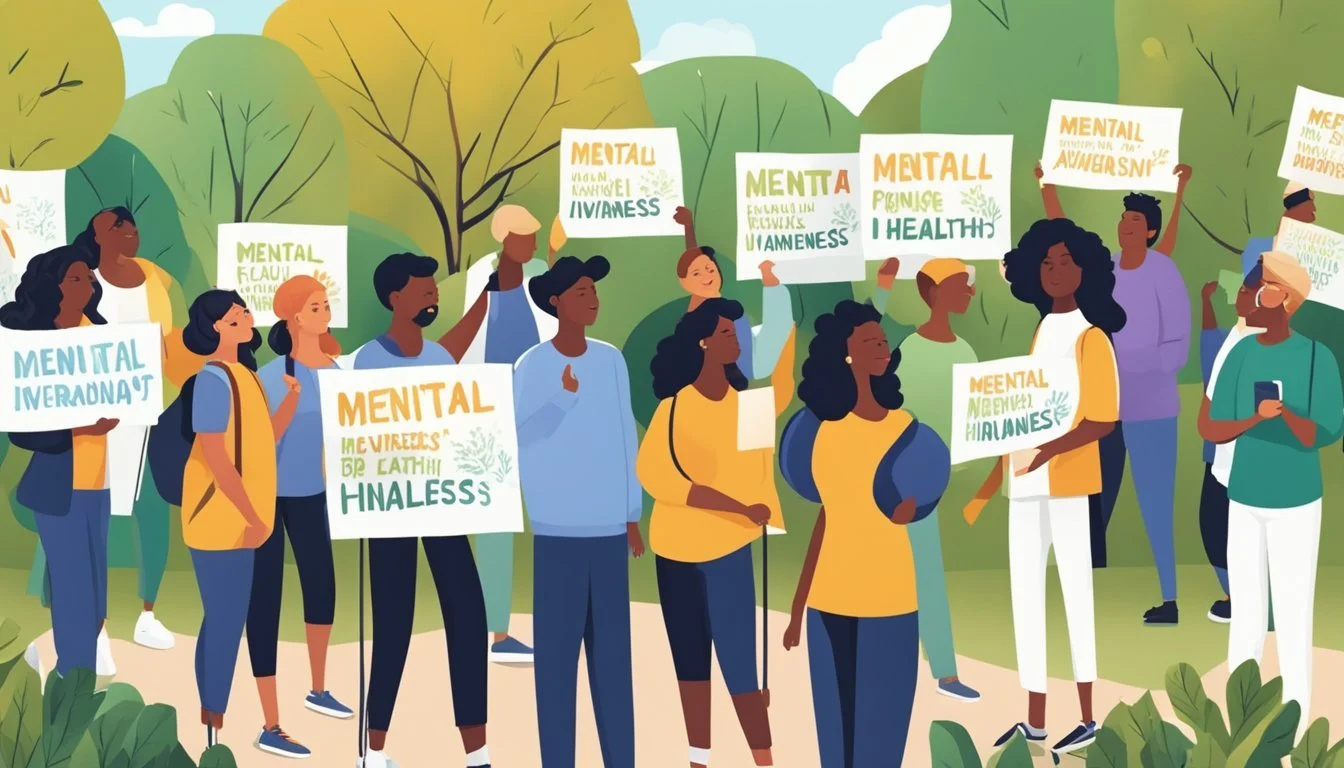What Month Is Mental Health Awareness Month and Why Is It So Important?
Mental Health Awareness Month takes place each May in the United States. This annual observance aims to raise awareness about mental health issues, reduce stigma, and promote understanding and support for those affected by mental health conditions. The month-long event provides an opportunity for individuals, organizations, and communities to come together and focus on mental health education and advocacy.
During Mental Health Awareness Month, various activities and initiatives are organized to increase public knowledge about mental health. These may include educational campaigns, support group meetings, fundraising events, and social media outreach efforts. The goal is to foster open conversations about mental health, encourage people to seek help when needed, and highlight available resources and treatment options.
Mental Health Awareness Month serves as a reminder that mental health is an essential component of overall well-being. By dedicating a specific month to this topic, organizers hope to create lasting change in how society perceives and addresses mental health issues. The observance also provides a platform for individuals to share their experiences, connect with others, and access valuable information and support.
Historical Background
Mental Health Awareness Month has a rich history spanning over seven decades. This observance has played a crucial role in destigmatizing mental health issues and promoting public understanding.
Origin of Mental Health Awareness Month
Mental Health Awareness Month (MHAM) was established in 1949 by Mental Health America (MHA), then known as the National Association for Mental Health. The campaign aimed to educate the public about mental illnesses and promote mental wellness.
Initially, MHAM focused on raising awareness about conditions like depression, schizophrenia, and bipolar disorder. Over time, it expanded to address a broader range of mental health concerns.
The month of May was chosen for this observance, allowing for various events and activities to be organized nationwide. These initiatives have helped foster dialogue and understanding about mental health issues.
Role of Mental Health America (MHA)
Mental Health America has been the driving force behind MHAM since its inception. As a leading community-based nonprofit, MHA has consistently worked to promote mental health as a critical part of overall wellness.
MHA's efforts include:
Organizing annual campaigns with specific themes
Providing educational resources and toolkits
Advocating for policy changes to improve mental health services
Collaborating with other organizations to expand the reach of MHAM
Through these initiatives, MHA has significantly contributed to reducing stigma and increasing access to mental health support. The organization continues to adapt its strategies to address evolving mental health needs in society.
Significance and Goals
Mental Health Awareness Month aims to increase understanding of mental health issues and promote support for those affected. It focuses on education, destigmatization, and encouraging positive action.
Increase Public Knowledge
Mental Health Awareness Month educates the public about common mental health conditions. It provides information on symptoms, treatments, and resources available. The campaign highlights statistics to show the prevalence of mental illness. It also emphasizes that mental health is an essential component of overall wellbeing.
Educational events and materials cover topics like depression, anxiety, bipolar disorder, and schizophrenia. The month promotes understanding of how these conditions impact daily life. It also teaches strategies for maintaining good mental health and recognizing warning signs.
Eradicate Stigma and Misconceptions
A key goal is reducing the stigma surrounding mental illness. The campaign challenges negative stereotypes and misconceptions. It promotes the message that mental health conditions are medical issues, not character flaws.
Personal stories from individuals living with mental illness help humanize these experiences. The month encourages open conversations about mental health in families, workplaces, and communities. It aims to create an environment where people feel comfortable seeking help without fear of judgment.
Encourage Support and Advocacy
Mental Health Awareness Month motivates people to support those affected by mental health conditions. It provides guidance on how to be an ally and offer assistance. The campaign promotes the importance of listening without judgment and encouraging professional help when needed.
It also inspires advocacy efforts. This includes pushing for improved mental health services, insurance coverage, and workplace accommodations. The month highlights opportunities to volunteer with mental health organizations or participate in awareness events. It emphasizes that everyone can play a role in creating a more supportive society for mental health.
Themes and Activities
Mental Health Awareness Month features annual themes, national and local events, and educational programs to promote understanding and support. These initiatives aim to raise awareness, reduce stigma, and provide resources for mental health.
Annual Themes
Each year, Mental Health Awareness Month adopts a specific theme to focus public attention on key issues. In 2024, the theme is "Where to Start," emphasizing coping skills development in a changing world. The 2023 theme was "Look Around, Look Within," encouraging self-reflection and community support.
Themes guide organizations and individuals in creating targeted campaigns and activities. They help frame discussions around mental health, making complex topics more accessible to the general public.
National and Local Events
NAMIWalks are popular nationwide events that bring communities together to support mental health awareness. These walks raise funds and promote solidarity among those affected by mental health conditions.
Local organizations often host workshops, seminars, and support group meetings during May. These events provide valuable information and resources to community members. Many cities organize art exhibitions, film screenings, and musical performances to explore mental health themes creatively.
Social media campaigns play a crucial role in spreading awareness. Hashtags and online challenges encourage people to share their experiences and support others.
Tools 2 Thrive Program
The Tools 2 Thrive program offers practical strategies for maintaining mental health. It provides free, downloadable toolkits with materials on various topics such as:
Dealing with anger and frustration
Getting out of thinking traps
Practicing gratitude
Recognizing warning signs of mental health problems
These resources help individuals develop coping mechanisms and resilience. The program emphasizes self-care activities like meditation, yoga, and nature walks.
Organizations can use Tools 2 Thrive materials to create workplace wellness programs or community outreach initiatives. Schools often incorporate these resources into their mental health education curricula.
Mental Health Issues in Focus
Mental health awareness encompasses a wide range of conditions affecting individuals across all age groups. Understanding these issues is crucial for promoting early intervention and support.
Common Mental Illnesses
Depression and anxiety are among the most prevalent mental health disorders worldwide. Depression affects over 280 million people globally, causing persistent feelings of sadness and loss of interest. Anxiety disorders, impacting nearly 300 million individuals, involve excessive worry and fear.
Both conditions can significantly impair daily functioning. Symptoms of depression include changes in sleep patterns, appetite, and energy levels. Anxiety often manifests as restlessness, irritability, and difficulty concentrating.
Treatment options for these disorders typically involve a combination of therapy and medication. Cognitive-behavioral therapy (CBT) has shown effectiveness in managing symptoms for many patients.
Youth and Mental Health
Mental health issues among children and adolescents are on the rise. Approximately 1 in 7 adolescents experiences a mental health disorder globally. Common conditions include:
Attention-deficit/hyperactivity disorder (ADHD)
Anxiety disorders
Depression
Eating disorders
Early intervention is key in addressing youth mental health. Schools play a crucial role in identifying and supporting students struggling with mental health issues. Implementing mental health education in curriculums can help reduce stigma and promote help-seeking behaviors.
Family support and open communication are vital for youth mental well-being. Encouraging healthy coping mechanisms and fostering resilience can significantly impact long-term mental health outcomes.
Maternal Mental Health
Perinatal mental health disorders affect up to 20% of women during pregnancy and the postpartum period. These conditions include:
Postpartum depression
Anxiety disorders
Obsessive-compulsive disorder (OCD)
Postpartum psychosis (rare but severe)
Symptoms can range from mild to severe, impacting both the mother and child's well-being. Risk factors include a history of mental illness, lack of social support, and hormonal changes.
Screening for maternal mental health issues during prenatal and postnatal care is essential. Treatment options may include therapy, support groups, and medication when necessary. Promoting awareness and reducing stigma surrounding maternal mental health is crucial for ensuring timely care and support.
Serious Mental Illnesses
Serious mental illnesses (SMIs) are severe, persistent conditions that significantly impact daily functioning. Key SMIs include:
Schizophrenia: Affects about 1% of the population, causing distorted thinking and perceptions.
Bipolar disorder: Characterized by extreme mood swings, affecting approximately 2.8% of adults in the U.S.
Major depressive disorder: A severe form of depression impacting about 7% of adults annually.
These conditions often require long-term management and support. Treatment typically involves a combination of medication, therapy, and psychosocial interventions. Early diagnosis and consistent treatment can significantly improve outcomes and quality of life for individuals with SMIs.
Community support and understanding play crucial roles in reducing stigma and promoting recovery for those with serious mental illnesses.
Resources and Support
Mental Health Awareness Month provides an opportunity to connect with valuable resources and support services. Organizations, treatment options, and helplines are available to assist individuals seeking help for mental health concerns.
Organizations and Initiatives
The National Alliance on Mental Illness (NAMI) plays a crucial role in mental health advocacy and education. NAMI offers support groups, educational programs, and a helpline for individuals and families affected by mental illness.
The Substance Abuse and Mental Health Services Administration (SAMHSA) is a federal agency that provides funding, resources, and information to improve mental health services. SAMHSA's website offers a treatment locator tool and educational materials on various mental health topics.
State mental health organizations and NAMI affiliates provide local resources and support services tailored to community needs. These groups often host events, support groups, and educational workshops during Mental Health Awareness Month.
Mental Health Services and Treatment
Mental health services encompass a wide range of options to address various needs. These include:
Psychotherapy (individual, group, or family counseling)
Medication management
Inpatient and outpatient treatment programs
Crisis intervention services
Peer support groups
Many healthcare providers offer mental health screenings and assessments to help identify potential concerns. Early intervention and appropriate treatment can significantly improve outcomes for individuals with mental health conditions.
Finding Help: Websites and Helplines
Several online resources and helplines provide immediate support and information:
SAMHSA's National Helpline: 1-800-662-HELP (4357)
National Suicide Prevention Lifeline: 988
NAMI HelpLine: 1-800-950-NAMI (6264)
The FindSupport.gov website, maintained by SAMHSA, offers a comprehensive directory of mental health services and treatment facilities across the United States. Users can search for local resources based on their specific needs and location.
Many mental health organizations also provide online chat services and text-based support for those who prefer non-verbal communication options. These services can be especially helpful for individuals who may feel uncomfortable speaking on the phone.
Policy and Advocacy
Mental health advocacy efforts focus on improving policies, legislation, and community support. These initiatives aim to enhance access to care, reduce stigma, and promote overall mental well-being.
Legislation for Mental Health
The Mental Health Parity and Addiction Equity Act of 2008 marked a significant step in mental health policy. This law requires health insurers to provide equal coverage for mental and physical health conditions.
Recent legislative efforts have focused on expanding telehealth services for mental health treatment. The CARES Act of 2020 included provisions to increase access to virtual mental health care during the COVID-19 pandemic.
State-level policies vary, with some states implementing mental health education requirements in schools. These programs aim to increase awareness and early intervention for mental health issues among youth.
Role of State Organizations
State mental health departments play a crucial role in implementing and overseeing mental health policies. They manage public mental health services, allocate funding, and coordinate with local providers.
The National Alliance on Mental Illness (NAMI) operates state chapters that advocate for improved mental health policies. These chapters work with state legislatures to push for better mental health care access and funding.
Mental Health America (MHA) affiliates in various states conduct policy research and provide recommendations to state governments. They often focus on issues such as expanding community-based services and improving crisis response systems.
Volunteering and Community Involvement
Grassroots advocacy is essential for driving mental health policy changes. Individuals can volunteer with organizations like NAMI or MHA to participate in awareness campaigns and lobbying efforts.
Many mental health organizations offer training programs for volunteer advocates. These programs equip participants with knowledge about mental health policies and effective advocacy strategies.
Community involvement often includes participating in local mental health awareness events. These events help raise public awareness and can influence local policymakers to prioritize mental health initiatives.
Peer support programs, where individuals with lived experience of mental health challenges support others, are gaining recognition in policy discussions. Many states are working to integrate peer support services into their mental health systems.
Prevention and Wellness
Mental health awareness emphasizes proactive approaches to maintain psychological well-being. Prevention strategies, wellness practices, and mindfulness techniques play crucial roles in fostering mental resilience and supporting recovery.
Preventive Strategies
Early intervention and risk reduction form the cornerstone of mental health prevention. Regular mental health screenings can identify potential issues before they escalate. Education programs in schools and workplaces raise awareness about mental health conditions and reduce stigma.
Promoting healthy lifestyle choices is essential. Regular exercise, balanced nutrition, and adequate sleep contribute significantly to mental wellness. Stress management techniques, such as deep breathing exercises and time management skills, help individuals cope with daily pressures.
Social connections act as a protective factor. Encouraging strong support networks through community programs and social activities can prevent isolation and loneliness.
Wellness and Mental Well-being
Mental well-being encompasses more than the absence of illness. It involves cultivating positive emotions, engagement, and a sense of purpose. Self-care practices are fundamental to maintaining mental wellness.
Key self-care strategies include:
Setting realistic goals
Practicing gratitude
Engaging in hobbies and leisure activities
Maintaining work-life balance
Seeking professional help when needed
Employers can promote workplace wellness through flexible schedules, mental health days, and employee assistance programs. Community centers often offer wellness workshops and support groups to foster collective well-being.
Mindfulness and Recovery
Mindfulness practices have gained recognition for their benefits in mental health prevention and recovery. These techniques help individuals stay present, reduce anxiety, and manage stress.
Popular mindfulness activities include:
Meditation
Yoga
Journaling
Breathing exercises
For those recovering from mental illness, mindfulness can complement traditional treatments. It aids in emotional regulation, improves focus, and enhances self-awareness.
Recovery-oriented care emphasizes personal growth and empowerment. Peer support groups provide valuable connections for individuals sharing similar experiences. Developing coping skills and building resilience are essential components of the recovery process.
Research and Education
Mental Health Awareness Month promotes research and education to enhance understanding of mental health issues. Key organizations provide resources and conduct studies to advance knowledge and improve treatments.
Role of National Institute of Mental Health (NIMH)
NIMH leads mental health research efforts in the United States. The institute funds studies on various mental disorders, brain function, and innovative treatments. NIMH collaborates with universities and medical centers to conduct clinical trials and basic research.
NIMH also develops educational materials for the public and healthcare professionals. These resources cover topics like depression, anxiety, and schizophrenia. The institute's website offers fact sheets, statistics, and treatment information.
Researchers at NIMH use advanced technologies like brain imaging to study mental illnesses. Their findings contribute to new diagnostic methods and therapeutic approaches.
Educational Resources and Graphics
Organizations create accessible materials to educate the public during Mental Health Awareness Month. These include infographics, videos, and social media content.
The National Alliance on Mental Illness (NAMI) produces shareable graphics highlighting mental health statistics. These visuals help spread awareness on platforms like Instagram and Twitter.
Mental Health America offers downloadable toolkits for schools and workplaces. These kits contain presentation templates, fact sheets, and activity ideas.
The Centers for Disease Control and Prevention (CDC) provides data-driven infographics on mental health prevalence. These graphics help illustrate the scope of mental health issues in the U.S.
Substance Abuse and Mental Health Reports
The Substance Abuse and Mental Health Services Administration (SAMHSA) releases annual reports on mental health and substance use. These comprehensive studies provide valuable data for policymakers and health professionals.
SAMHSA's National Survey on Drug Use and Health offers insights into mental illness prevalence. The report covers topics like co-occurring disorders and treatment utilization.
The agency also produces specialized reports on youth mental health trends. These studies help inform prevention and intervention strategies for schools and communities.
SAMHSA's data informs public health initiatives and resource allocation. Researchers and advocates use these reports to identify gaps in mental health services.







